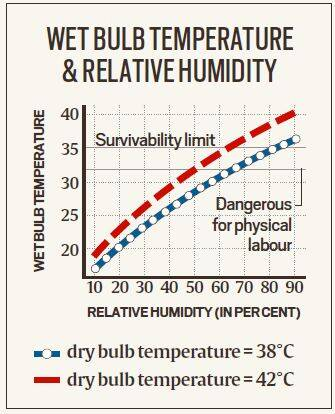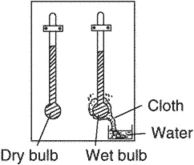Biodiversity & Environment
Heatwaves and Wet Bulb Temperature
- 09 May 2022
- 8 min read
For Prelims: Wet bulb temperature, Dry bulb temperature, Intergovernmental Panel on Climate Change, IPCC Report AR6, Heatwaves.
For Mains: Environmental Pollution & Degradation, Conservation, Wet bulb temperature, Impact of rising wet bulb temperature, Heatwaves.
Why in News?
The recently published Intergovernmental Panel on Climate Change (IPCC) Report AR6 (Sixth Assessment Report) has emphasised that humidity is very important factor while estimating the physiological stress that extreme heat puts on the human body.
- Instead of the “dry bulb” temperature which is usually measured using a regular thermometer, an alternative metric known as the “wet bulb temperature” has been used to measure exposure to extreme heat.
- Since March 2022, the consecutive heatwaves over South Asia have continued the disturbing tradition of breaking historical temperature records.
What are Heatwaves?
- A heatwave is a period of abnormally high temperatures, more than the normal maximum temperature that occurs during the summer season in the North-Western and South Central parts of India.
- Heatwaves typically occur between March and June, and in some rare cases even extend till July.
- India Meteorological Department (IMD) classifies heatwaves according to regions and their temperature ranges.
What is the Criteria for Heatwaves?
- The heatwave is considered when the maximum temperature of a station reaches at least 40°C for Plains and at least 30°C for Hilly regions.
- If the normal maximum temperature of a station is less than or equal to 40°C, then an increase of 5°C to 6°C from the normal temperature is considered to be heat wave condition.
- Further, an increase of 7°C or more from the normal temperature is considered a severe heat wave condition.
- If the normal maximum temperature of a station is more than 40°C, then an increase of 4°C to 5°C from the normal temperature is considered to be heat wave condition. Further, an increase of 6°C or more is considered a severe heat wave condition.
- Additionally, if the actual maximum temperature remains 45°C or more irrespective of normal maximum temperature, a heat wave is declared.
Why is Humidity such a Critical factor while Measuring Heat Exposure?
- Humans lose heat generated within their bodies by producing sweat that evaporates on the skin.
- The cooling effect of this evaporation is essential in maintaining a stable body temperature.
- As humidity rises, sweat does not evaporate and makes it difficult to regulate body temperature. This is why humans feel more discomfort in humid places.
- The wet bulb temperature is usually lower than the dry bulb temperature, and the difference between the two increases dramatically as the air becomes dry.
- The report mentions that sustained exposures to wet bulb temperatures above 35°C are fatal, while sustained exposures to wet bulb temperatures above 32°C are dangerous for intense physical activity.
- The humidity required to reach wet bulb temperatures in excess of 35°C over land is exceedingly difficult to achieve.
- According to the report, such conditions are rarely observed nowadays.
- The findings also suggest that it is unlikely to experience sustained exposure to wet bulb temperatures beyond the threshold of survivability.
- The hype around survivability thresholds and wet bulb temperatures hides deeper issues, both physiological and political.
- Firstly, the inability of the body to stabilise its core temperature can have multiple reasons.
- Increased strain on the heart during periods of elevated temperature could be fatal for those with pre-existing cardiac conditions which is the leading cause of deaths during heatwaves.
- Pre-existing respiratory problems and diabetes too are potential causes of death.
- Such conditions impair the body’s ability to efficiently transfer heat to the environment.
- Firstly, the inability of the body to stabilise its core temperature can have multiple reasons.
What is the Wet Bulb Temperature?
- Wet bulb temperature is the lowest temperature to which air can be cooled by the evaporation of water into the air at a constant pressure.
- WBT is a limit that considers heat and humidity beyond which humans can not tolerate high temperatures.
- The Wet Bulb temperature is the temperature of adiabatic saturation. This is the temperature indicated by a moistened thermometer bulb exposed to the air flow.
- An adiabatic process is one in which no heat is gained or lost by the system.
- Wet Bulb temperature can be measured by using a thermometer with the bulb wrapped in wet muslin.
- The adiabatic evaporation of water from the thermometer and the cooling effect is indicated by a "wet bulb temperature" lower than the "dry bulb temperature" in the air.
- The rate of evaporation from the wet bandage on the bulb, and the temperature difference between the dry bulb and wet bulb, depending on the humidity of the air.
- The evaporation is reduced when the air contains more water vapour.
- The wet bulb temperature is always lower than the dry bulb temperature but will be identical with 100% relative humidity (the air is at the saturation line).
What is Dry Bulb Temperature?
- The Dry Bulb temperature usually referred to as "air temperature", is the air property that is most commonly used. When people refer to the temperature of the air they are normally referring to the dry bulb temperature.
- The Dry Bulb Temperature refers basically to the ambient air temperature. It is called "Dry Bulb" because the air temperature is indicated by a thermometer not affected by the moisture of the air.
- Dry-bulb temperature can be measured using a normal thermometer freely exposed to the air but shielded from radiation and moisture.
- The dry-bulb temperature is an indicator of heat content.






